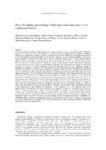Mostrar o rexistro simple do ítem
Does the epiphyseal cartilage of the long bones have one or two ossification fronts?
| dc.contributor.author | Delgado-Martos, María Jesús | |
| dc.contributor.author | Touza Fernández, Alberto | |
| dc.contributor.author | Canillas, Fernando | |
| dc.contributor.author | Quintana-Villamandos, Begoña | |
| dc.contributor.author | Santos-del-Riego, Sergio | |
| dc.contributor.author | Delgado-Martos, Emilio | |
| dc.contributor.author | Martos-Rodríguez, Antonia | |
| dc.contributor.author | Delgado-Baeza, Emilio | |
| dc.date.accessioned | 2016-05-05T11:40:23Z | |
| dc.date.available | 2016-05-05T11:40:23Z | |
| dc.date.issued | 2013-08-13 | |
| dc.identifier.citation | Delgado-Martos MJ, Touza Fernández A, Canillas F, et al. Does the epiphyseal cartilage of the long bones have one or two ossification fronts?. Med Hyphotheses. 2013;81(4):695-700 | es_ES |
| dc.identifier.uri | http://hdl.handle.net/2183/16602 | |
| dc.description.abstract | [Abstract] Epiphyseal cartilage is hyaline cartilage tissue with a gelatinous texture, and it is responsible for the longitudinal growth of the long bones in birds and mammals. It is located between the epiphysis and the diaphysis. Epiphyseal cartilage also is called a growth plate or physis. It is protected by three bone components: the epiphysis, the bone bar of the perichondrial ring and the metaphysis. The epiphysis, which lies over the epiphyseal cartilage in the form a cupola, contains a juxtaposed bone plate that is near the epiphyseal cartilage and is in direct contact with the epiphyseal side of the epiphyseal cartilage. The germinal zone corresponds to a group of cells called chondrocytes. These chondrocytes belong to a group of chondral cells, which are distributed in rows and columns; this architecture is commonly known as a growth plate. The growth plate is responsible for endochondral bone growth. The aim of this study was to elucidate the causal relationship between the juxtaposed bone plate and epiphyseal cartilage in mammals. Our hypothesis is that cells from the germinal zone of the epiphyseal side of the epiphyseal cartilage are involved in forming a second ossification front that is responsible for the origin of the juxtaposed bone plate. We report the following: (a) The juxtaposed bone plate has a morphology and function that differs from that of the epiphyseal trabeculae; (b) on the epiphyseal edge of the epiphyseal cartilage, a new ossification front starts on the chondrocytes of the germinal area, which forms the juxtaposed bone plate. This ossification front is formed by chondrocytes from the germinal zone through a process of mineralisation and ossification, and (c) the process of mineralisation and ossification has a certain morphological analogy to the process of ossification in the metaphyseal cartilage of amphibians and differs from the endochondral ossification process in the metaphyseal side of the growth plate. The close relationship between the juxtaposed bone plate and the epiphyseal cartilage, in which the chondrocytes that migrate from the germinal area play an important role in the mineralisation and ossification process of the juxtaposed bone plate, supports the hypothesis of a new ossification front in the epiphyseal layer of the epiphyseal plate. This hypothesis has several implications: (a) epiphyseal cartilage is a morphological entity with two different ossification fronts and two different functions, (b) epiphyseal cartilage may be a morphological structure with three parts: perichondrial ring, metaphyseal ossification front or growth plate, and epiphyseal ossification front, (c) all disease (traumatic or dysplastic) that affects some of these parts can have an impact on the morphology of the epiphyseal region of the bone, (d) there is a certain analogy between metaphyseal cartilage in amphibians and mammalian epiphyseal cartilage, although the former is not responsible for bone growth, (e) comparative histological and anatomy studies are also warranted, to shed light on the phylogenetic study of epiphyseal cartilage throughout the changes that occur in the animal species. | es_ES |
| dc.language.iso | eng | es_ES |
| dc.publisher | Elsevier | es_ES |
| dc.relation.uri | http://dx.doi.org/10.1016/j.mehy.2013.07.029 | es_ES |
| dc.rights | Atribución-NoComercial-SinDerivadas 3.0 España | es_ES |
| dc.rights.uri | http://creativecommons.org/licenses/by-nc-nd/3.0/es/ | * |
| dc.title | Does the epiphyseal cartilage of the long bones have one or two ossification fronts? | es_ES |
| dc.type | info:eu-repo/semantics/article | es_ES |
| dc.rights.access | info:eu-repo/semantics/openAccess | es_ES |
| UDC.journalTitle | Medical Hypotheses | es_ES |
| UDC.volume | 81 | es_ES |
| UDC.issue | 4 | es_ES |
| UDC.startPage | 695 | es_ES |
| UDC.endPage | 700 | es_ES |
Ficheiros no ítem
Este ítem aparece na(s) seguinte(s) colección(s)
-
II - Artigos [692]






